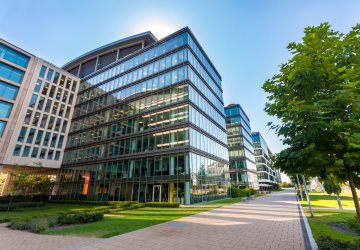
Worldwide attention on sustainability is growing fast, and rightly so. As many organizations are increasingly contemplating the role they can, and should play, in reaching sustainability goals, they will undoubtedly scrutinize their built environment. With its focus on maintaining, improving, and adapting the built environment to support an organization's objectives, facility management is an important player in setting, measuring and attaining those sustainability goals.
The underlying goal of sustainable facility management is to decrease the impact on our planet and improve the health, well-being, and productivity of building occupants, both now and in the future.
In this blog, we will discuss the positive impact that sustainable facility management can have on the physical and social environment, why this is more urgent for facility management than ever before, and the role that IoT plays in making sure that the sustainability vision is a success for organizations around the globe.
Sustainability: The Urgency
Sources agree that approximately 40% of organizations' CO2 emissions and over 50% of electricity consumption come from their buildings, and approximately 80% of energy use over the life cycle of a building results from the building’s operations, or ‘operational energy’. (Using Data to Drive Workplace Innovation and Sustainability report, Frost & Sullivan, 2022). This creates opportunities to maximize the performance of assets such as heating, HVAC units, lighting, machinery, and IT systems, as well as the efficiency of the occupants themselves. In fact, achieving comfortable conditions is not solely a matter of increasing lighting levels or adjusting temperatures in response to an uncomfortable temperature in the environment. Instead, it is a question of finding the optimal conditions and identifying the psychological root of sustainable behaviors.
According to Frost & Sullivan (2022), ‘sustainability will be one of the big differentiators over the next few years for all types of companies.’ For a variety of reasons, including a push for a green recovery from the pandemic, it is now apparent that after decades of contemplating, the era of sustainability urgency is officially here.
Sustainable facilities and IoT
The urgency may be here, however, we cannot track change and improvement from sustainability initiatives if we don’t have the data to back it up. As more and more companies acknowledge the benefits of having a sustainability agenda, they are also recognizing that tracking their success requires real data coming from people, devices and assets. This data enables the creation of KPIs against set goals, the means to report the data and to help managers make the best decisions.
In today’s buildings, technology and data have become critical in helping companies discover real opportunities. IoT technology plays a major role in delivering this data. Use cases relating to facility management such as space occupancy, room availability, asset management, maintenance, etc., can present huge risks to an organization if there are unknowns. Such risks include unexpected costs, poor space utilization, faulty asset maintenance, and general interruptions to daily business.
It should be on the mind of every facility manager today, that the above-mentioned risks are all related to an organization's carbon footprint, i.e. any loss of efficiency in people or building assets is a loss of sustainability! With technology and data visualization, the guess work is eliminated, enabling facility managers to make educated choices that enhance the sustainability of corporate buildings and of their occupants’ behavior.
An IoT platform is key to this success. By connecting software, devices and sensors into one integrated system, building managers gain real-time visualization, and the ability to monitor every aspect of the building, with clear business insights. Not only do managers have the data to make better decisions and report on performance, they are also empowered by the ability to quickly react to issues, thereby optimizing energy consumption, space utilization, safety precautions, asset management, etc.
For example, companies can connect an IoT platform such as Axonize to their room booking systems, and receive real-time data from the sensors on how space is used. Analyzing this data enables them to optimize their shared workspaces. Using IoT technology, organizations can still reduce operational costs and space occupancy, despite a large variance in space utilization, like we see now due to COVID-19. Additionally, with an IoT platform, organizations can continuously monitor indoor air quality based on CO2, humidity, and temperature across all facilities in one dashboard. By analyzing and optimizing these room parameters, buildings become more environmentally sustainable, and more healthy and secure for their occupants.
The future of sustainability and IoT
Our lives are becoming more complicated in this new era. However, with this complexity comes more opportunity to make a difference – both to the social, environmental and governmental aspects of the organization. The trend towards digital, smart and intuitive technology is altering the way we use data to optimize resources, and digitize our buildings, user actions and environment. IoT is making strides to deliver enhanced utilization of devices and systems, with sustainability at the core. In fact, researchers estimate that by 2025, IoT will have an economic impact worth $11.1 trillion. On a global scale, organizations are quickly realizing that they can use IoT to reach their sustainability goals, from improving the well-being of their building occupants, to enhancing the entire planet.
How Planon and Axonize support
For years now, Planon has been recognized as a strong, global IWMS leader. With Planon’s recent acquisition of Axonize, its vision of enabling enterprise building digitalization and sustainability by integrating smart building technology, business solutions and data into one source of truth is coming to fruition. Enabling building owners/users to mitigate environmental impact and improve the well-being and productivity of building occupants is now becoming a reality.
Axonize specializes in bringing IoT data capture and analytics capabilities to offices and facilities, with a no-code IoT platform that enables easy configuration. The solution offers out-of-the-box connectivity to smart devices and other data sources, which are fed into the Planon Platform. The acquisition is bolstering Planon’s ability to collect IoT and digital twin data from across the built environment. This data capture helps organizations improve their monitoring of buildings and supports an endless number of new use cases that rely on rich asset data, such as predictive maintenance.
Do you want to learn more about the role of an IWMS solution in driving workplace innovation and sustainability? Read this recent industry report from Frost & Sullivan. Learn more about the Axonize-Planon partnership in one of our latest press releases.




















